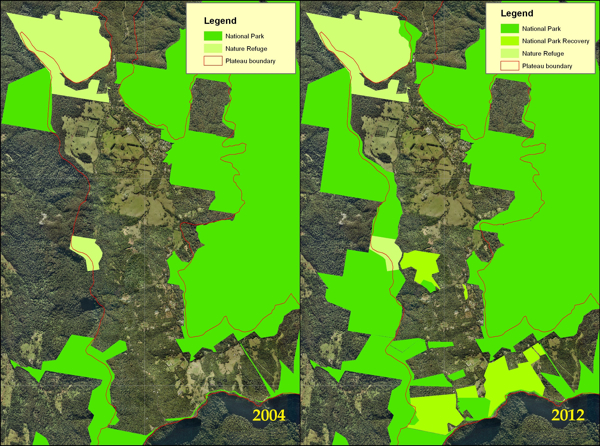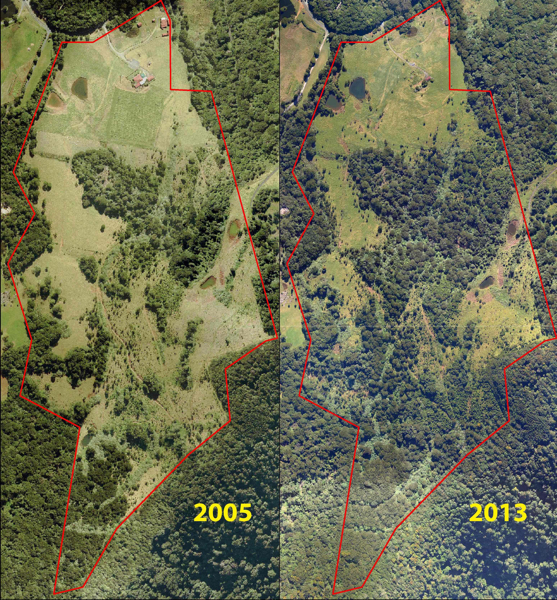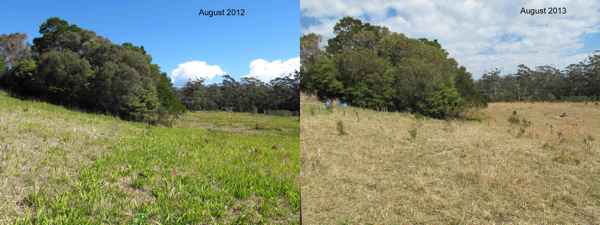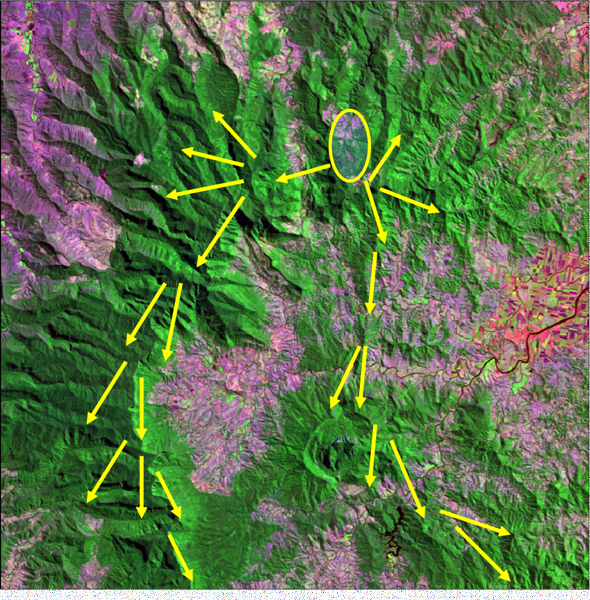 |
Why rainforests? | Who we are | What we do | Places we protect | How you can help | News | Join us | Donate |
The facts about Springbrook RescueSpringbrook Rescue is a major long-term project that has wide support. We were shocked by recent newspaper articles about the project. In September 2013, ARCS President, Dr Aila Keto, and the Society itself were the subject of crticism in the news media by the Queensland Government and the Queensland newspaper, The Courier-Mail. Leading the attack were Assistant Editor, Des Houghton, and the Member for the electorate of Mudgeeraba, Ros Bates MP. This is despite a formal, legal partnership between ARCS and the Queensland Government.
Over ARCS’s 31-year history, this is the first time there has ever been an attack on our integrity. The claims made by Mr Houghton and Ms Bates are thoroughly unfounded. Des Houghton wrote the first article on 4 September 2013 and followed up on 7 September. Following the first article, Dr Keto emailed a media statement to The Courier-Mail and ARCS Director, Dr Keith Scott, wrote a letter to the editor correcting misleading statements made by Houghton. Both Dr Keto and Dr Scott spoke by telephone with Houghton giving him the real story. Despite these communications, Houghton’s follow-up article made no reference at all to the facts provided to him. He continued to quote misleading and often erroneous statements made under parliamentary privilege by Ms Bates.
Background Springbrook National Park is the wet heart of the Gondwana Rainforests of Australia World Heritage Area. However, the park was too small and the boundaries poorly configured to ensure long-term survival of World Heritage values. Between 2004 and 2009, the former Queensland Labor Government purchased 45 properties to add to the national park and, in the future, to the World Heritage Area. ARCS undertook to restore rainforest on cleared land that existed on some of the properties at no cost to taxpayers. An agreement between ARCS and the Government was entered into to provide security. The accusations Following are some quotes from the Houghton article and our responses:
“A conservationist has been accused of a conflict of interest over a deal that saw her rainforest society win control of massive tracts of land some at rents of $1 for 10 years.” “conflict of interest” The Minister for National Parks, Recreation, Sport and Racing, Hon Steve Dickson MP, commissioned law firm Minter Ellison to provide an audit report on the Labor Government’s land purchase at Springbrook. Whereas Houghton is quoting from that report, he nevertheless ignored information provided to him by Dr Keto. We note that Minter Ellison did not consult ARCS at any time, a clear breach of natural justice, made worse by the government selectively and confidentially leaking their report to a journalist and not giving it to ARCS. A conflict of interest occurs when a party takes part in a decision from which they derive benefit. Neither ARCS nor Dr Keto derive any financial or material benefit from the “deal”. In reality, ARCS contributes around $300,000 annually in cash and in kind to restoration on the national park. And Dr Keto’s involvement in the project is as a volunteer. Dr Keto’s involvement in a Steering Committee during the land acquisition phase was as an expert advisor on World Heritage values and integrity (Dr Keto was a co-author of 3 successful World Heritage nominations and a member of the board of the Wet Tropics Management Authority for 7 years). It was not a decision-making committee, rather one to draw relevant information together to assist normal government decision-making processes on land acquisition. Dr Keto conducted scientific surveys and provided written evaluation reports, pro bono, valued at $350,000. “control of massive tracts of land” The use of the word ‘control’ negatively implies that ARCS can do whatever it wishes with the land. In fact, all we can do is carry out restoration works prescribed in a legally binding agreement between ARCS and the Government registered under Section 34 of the Queensland Nature Conservation Act and the Regeneration Plan: Springbrook National Park (recovery). Our work requires the oversight and approval of a Steering Committee chaired by the Government and a Scientific Advisory Committee. The LNP government, on gaining office disbanded the World Heritage and Partnerships Unit with administrative oversight, and with it most the public servants with corporate memory lost their jobs. We have repeatedly but unsuccessfully sought the convening of a Steering Committee during the 18 months since the LNP Government took office. Moreover, the government website pages documenting the details of the partnership including all reports for public viewing were inexplicably removed. We have made these reports and other facts publicly available on our Springbrook Rescue website since January 2013. We do have access to three buildings, but only to accommodate volunteers travelling long distances to work on the project. The use of the words “massive tracts of land” does not accurately reflect the 224 hectares that ARCS is directly responsible for restoring, pro bono, for the government under the formal partnership agreement. “rents of $1 for 10 years” ARCS pays a nominal $1 in rental for two properties with commercial accommodation businesses. ARCS purchased the businesses from the previous owners at commercial rates. Both properties were, under the previous government, intended for future transfer to national park. All profits from the businesses are applied to restoration of the national park. If the government charged commercial rental that would simply mean profits going back to treasury rather than being spent on the national park. Not one cent goes to ARCS. “However, the original restoration agreement does not require the society to deliver financial reports to government.“ ARCS has delivered audited financial statements to the Department every year for more than a decade. “There is something terribly wrong when a government does out money and favours and keeps the details hidden.” “doles out money and favours” The money was not doled out. The government bought properties on the open market, paying fair market price after independent valuation. Presumably, it is ARCS that has supposedly gained favours. Apparently, Des Houghton believes that agreeing to contribute $300,000 annually over 20 years to restore rainforest on public land at no cost to taxpayers is a favour! The Restoration Agreement provides for an annual grant of $10,000 to assist in covering expenditure required by the Agreement, e.g. public liability insurance and service charges (which together exceed $10,000). The LNP government has not provided the grant for 2011–12 or 2012–13 (in breach of the Agreement). “keeps the details hidden” Firstly, a government would not normally release details of commercial transactions such as buying land. Secondly, a government would not advertise the fact that they were seeking to buy land in a given area. That would lead to inflated prices. Thirdly, when land is purchased for national park the purpose is nature conservation. It is not normal practice to consult with the local community to see if they are in favour. Fourthly, the web site of the former Department of Environment and Natural Resources included a description of the project and downloadable copies of the Restoration Agreement and all reports produced by ARCS. The LNP government removed all references to the project. “Around $40 million of taxpayers money was supposedly spent on adding more rainforest land to the national park. But it has not been used to buy rainforest land but to buy out land used for homes, farms and businesses,” Bates said. Of the 705 hectares purchased, 650 hectares (92%) are covered with rainforest providing home for the plants and animals that contribute to World Heritage values. On the purchased properties, only three businesses were operating at the time and they continue to operate today. All profits from two, purchased by ARCS at commercial rates, go to funding restoration (i.e. a public benefit). ARCS runs these businesses pro bono and receives no financial benefit. The third, leased to a third party (Springbrook Mountain Manor) continues to operate. No businesses were closed. Of the 45 properties purchased by the Government, only two (6.3% of the area) operated as farms (cattle grazing). These were critical bottlenecks in landscape connectivity which, if not restored, threatened the viability of World Heritage values. Houghton reports Bates as asking “What value have Queensland taxpayers received for their $40 million buyback which was supposed to remove weeds and restore rainforest?” According to Houghton, “It’s a fair question.” But he did not seek an answer. The answer is that of the 705 hectares of land purchased, 650 hectares (92%) are covered with rainforest providing home for the plants and animals that contribute to World Heritage values. Further, the original park was too small and fragmented with boundaries poorly configured to be viable. Moreover the area did not comply with requirements of the Operational Guidelines of the World Heritage Convention and risked being removed from the World Heritage area at future inevitable formal reviews. The purchased land goes a long way towards remedying the deficiency providing connectivity and adding critical mass to the area. Protection of these areas is critical to the future of the World Heritage Area and the local economy dependent on World Heritage. “Mr Dickson (Minister for National Parks, Recreation, Sport and Racing) said it was not clear to him what benefits to the state, if any, came from the buyback.“ As noted above, the original park was too small, fragmented with boundaries poorly configured to be viable. Moreover the area did not comply with requirements of the Operational Guidelines of the World Heritage Convention and risked being removed from the World Heritage area at future inevitable formal reviews. The purchased land goes a long way towards remedying the deficiency providing connectivity and added critical mass to the area (as detailed in our reports to the government). Protection of these areas is critical to the future of the World Heritage Area and the local economy dependent on World Heritage. The map below illustrates the benefits of the buyback to the World Heritage Area.  “Bates and Springbrook residents say there appears to be very little improvement to the national park for such a large expenditure of money.“ The following images illustrate the improvements. 
The images above show the regeneration that has occurred on the property known as Pallida (formerly The Winery) — an increase in canopy cover from 31% to 60%. A connectivity corridor has developed between the original national park to the north and the Numinbah Nature Reserve in New South Wales to the south, both part of the World Heritage Area. 
The above image shows natural regeneration that has occurred on the property known as Warblers-in-the-Mist. Intervention by ARCS volunteers has been limited to control of weeds and grass. At least 2 million plants have regenerated on the combined restoration sites; threatened species are returning, some after 40 years absence from the plateau. 
This image shows the essential eradication of the weed, Aristea ecklonii, over a significant area on the Warblers property. Over 5 tonnes have been removed over the past 12 months alone by volunteers from scout, rotary, church, corporate, student, birdwatching and bushwalking groups travelling as much as 260 km from both NSW and QLD. This weed (common name, Blue Stars) is a very serious threat to the World Heritage Area. The first record for Queensland was from this property. Aristea can grow in the shade and form a dense ground cover in forest understorey, preventing regeneration of canopy species. It could potentially destroy forests not just locally but more broadly in the Gondwana Rainforests of Australia World Heritage area, transported by Crimson Rosellas to Lamington National Park and south into New South Wales.
The map below shows the potential spread of aristea onto Lamington Plateau, the Border Ranges, Mt Warning and Nightcap Range sections of the World Heritage Area.  |